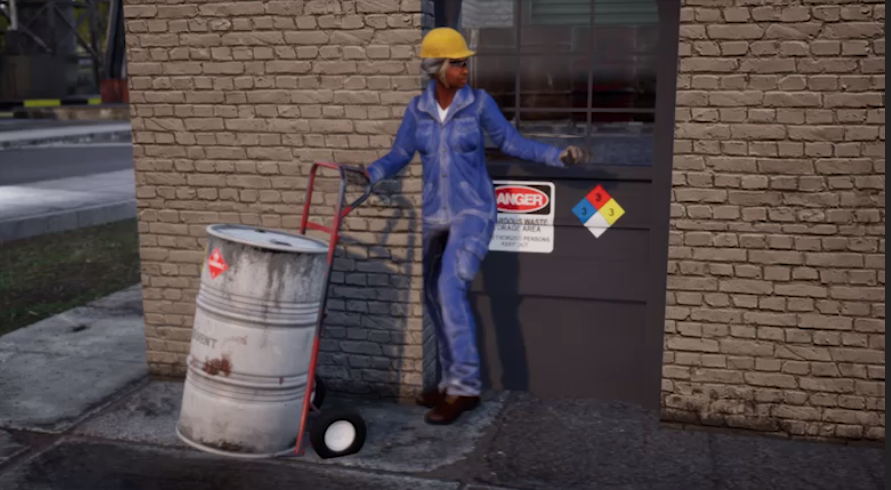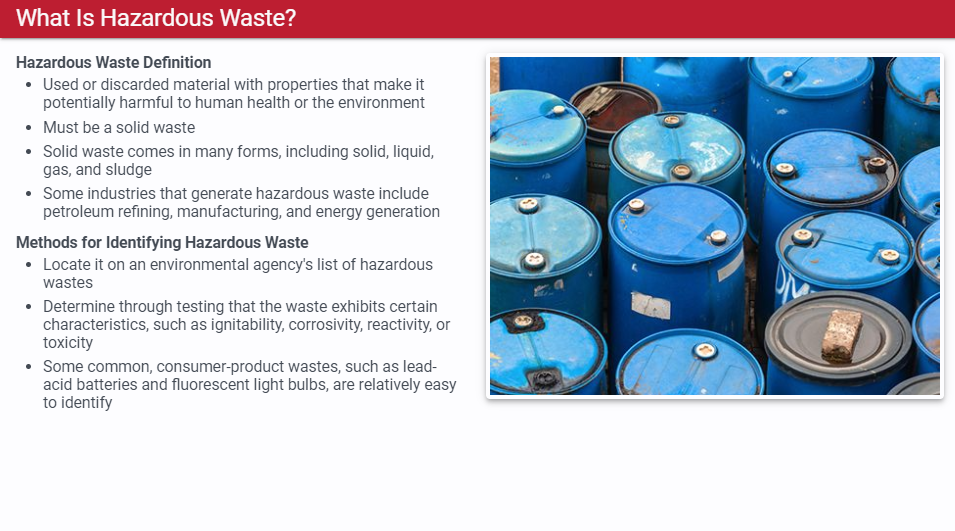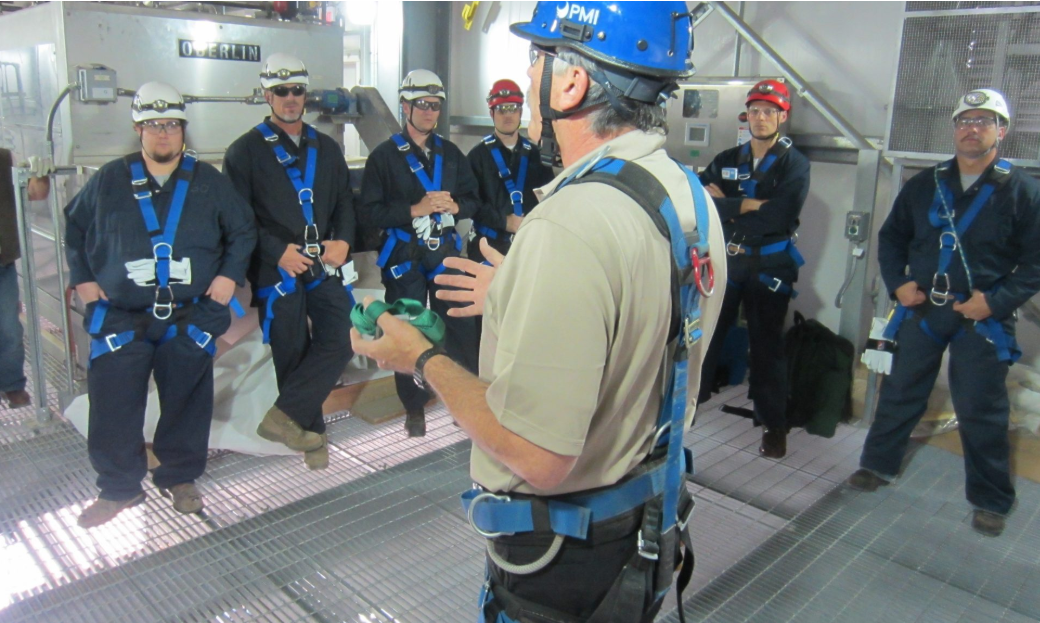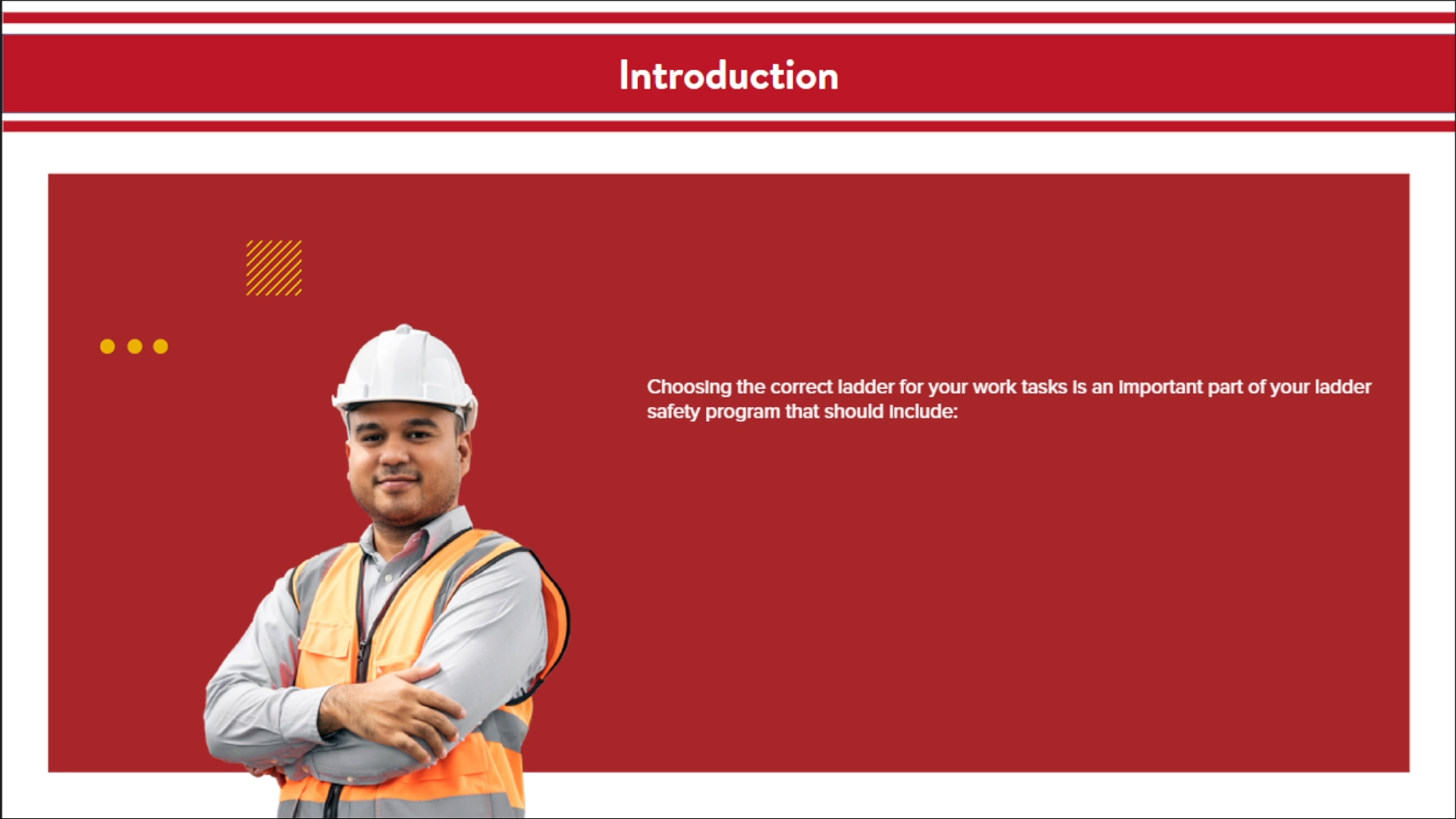This course covers the three classifications of waste generators under RCRA, examples of hazardous, universal and potentially hazardous waste, labeling, storage, disposal, transportation and emergency requirements for hazardous waste.
Hazardous Waste Management
$24.15
Description
Learning Objectives
- Define hazardous waste, explain the importance of managing it properly, and list the categories of hazardous waste generators.
- List some actions industrial facilities use to manage hazardous waste and explain how you can assist your company with its hazardous waste management efforts.
- Describe how to handle common types of hazardous waste.
- Describe how you, and other individuals with various roles and responsibilities, should respond to an unintended release of hazardous waste.
According to the Environmental Protection Agency (EPA), “Hazardous waste is waste that is dangerous or potentially harmful to our health or the environment. Hazardous wastes can be liquids, solids, gases, or sludges. They can be discarded commercial products, like cleaning fluids or pesticides, or the by-products of manufacturing processes.”
There is a growing awareness of the dangerous side effects of hazardous waste contamination. Years ago, many industrial plants discharged heavy metals and unstable organic compounds directly into streams or injected them into the earth’s subsurface through wells, causing illness in populations with close proximity to these toxic sites.
Nitrates, phosphates, and synthetic organic compounds in pesticides and fertilizers made their way into streams and ground water as a result of agricultural applications. With the arrival of the atomic age, radionuclide contamination emerged from man-made sources, like nuclear power plants.
Hazardous waste takes many physical forms. It may be solid, semi-solid, liquid, or gaseous. It can include spent solvents as well as many pesticides and excess, discarded, or spilled chemicals.
Hazardous waste is an environmental concern because:
- It remains intact for many years;
- It does not easily break down in the environment;
- It can be transferred among air, water, soils, and sediments;
- It can be transferred from one organism to another.
The World Health Organization (WHO) and the National Cancer Institute estimate that between 60 and 90 percent of cancers are environmentally induced by contaminates such as heavy metals and toxic chemicals.
Other chronic health effects from waste contaminants include stroke, kidney and thyroid disease, cardiovascular damage, nervous disorders, and impairment of speech, hearing, vision, and memory.
Hazardous wastes are now regulated to:
- Ensure safe treatment, storage, transportation, and disposal;
- Prevent the generation of hazardous waste through pollution prevention;
- Reduce the amount of any hazardous substance, pollutant, or contaminant released into the environment.
Treatment technologies may include:
- Distillation
- Stabilization
- Neutralization
- Incineration
- Evaporation
Avoid generating hazardous wastes by:
- Process modification (avoid the need for the hazardous material).
- Product substitution (purchase the least toxic substance available).
- Product purchase minimization (purchase minimum quantity and in small containers initially).
Waste Management Practices
- Place waste materials in their properly designated containers.
- Cover containers that hold chemicals.
- Label containers.
- Store chemicals out of the weather.
- Follow the guidelines for proper management, handling, and disposal of hazardous wastes or “unknowns”.
- Report chemical spills to your company’s Environmental or Health, Fire, & Safety Departments.
- Dispose of aerosol cans in a manner approved by state or local regulations (these normally incorporate provisions for capturing and safe disposal of any remaining container contents and disposal of the empty aerosol cans).
- Drain used oil filters and place in the marked container.
- Place used oil in bulk used oil containers.
- Never leave lids off of oil funnels, solvent containers, or other waste containers.
- Never place full or partially full aerosol cans in trash containers.
- Never place waste streams in improper, unlabeled containers.
- Avoid storing chemical containers on bare ground.
- Store chemical containers inside and on paved surfaces.
- Follow the spill release reporting guidelines for chemical releases and spills.
- For general waste management issues and questions, contact your company’s Environmental Department personnel for direction.
Precautions
- Procedures for proper response to an accidental spill or release should be in place.
- Emergency response supplies and equipment should be on hand.
- Waste receptacles should be clearly identified for the types of waste.
If you discover a hazardous material spill or release at work:
- Immediately report it to your manager, supervisor, building administrator, or company environmental organization.
- Call your company’s emergency number right away if it is life threatening or immediately hazardous.
Not all training is equal. With SafetyNow, learners and leaders will notice the difference in value:
- Quality: Professionally-researched and designed using the latest mobile and responsive technologies
- Convenience: Works instantly on any device, desktop or mobile
- Time savings: What learners need to know, not extra fluff or legalese
- Reporting: Consistent, instant compliance records available anytime
- Support: Customer and learner support included at no charge
- Any Learning Management System (LMS) Use with any SCORM, AICC, xAPI, TinCan, HTML5, or other LMS (learning management system).
- Any Device Desktop, laptop, tablet, or mobile phone – it simply works, everywhere.
- Engaging Professionally-developed, including an on-screen host and modern, easy-to-understand text, media, and voiceovers.
- Unlimited Attempts Each module can be taken as many times as required to get a passing grade. Unlike our competitor’s courses, if you get an answer wrong, you are redirected to the exact eLearning segment you struggled with… you don’t need to go through the entire module again, just the one part you need a refresher on.
Only logged in customers who have purchased this product may leave a review.













Reviews
There are no reviews yet.